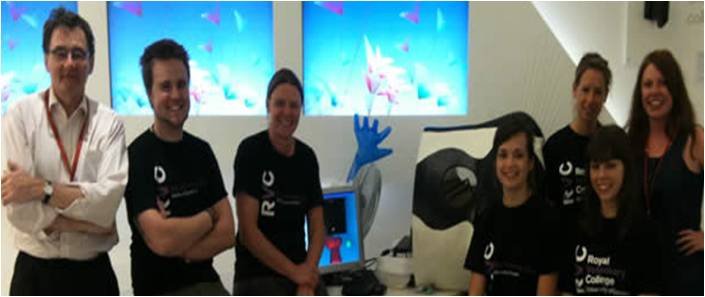Public Engagement and Widening Partcipation

Public Engagement and Widening Participation
Haptics is an excellent tool for engaging the public and young people in science, technology, veterinary medicine and education. The hands on nature of the simulators, and the presence of a rear-half of a fibreglass cow, always draws a crowd at public engagement events and catches the imagination of young people!
The Haptic Cow and her team have visited several exhibitions over the years including The Royal Society’s Summer Science Exhibition 2009, the Royal Institution’s Family Fun Day 2009, the British Library 2011, the Science Museum’s ‘Lates’ 2012 and the RVC’s own ‘RVC late’ in 2012. Most recently Haptic Cow inventor Sarah Baillie and RVC LIVE Haptic Cow Team Leader Tierney Kinnison took the Cow to the Royal Institution to record their annual CHRISTMAS LECTURE which was broadcast on 30th December 2014. Thousands of members of the general public have had a go on the Haptic Cow and other veterinary simulators, including the Core Skills Trainer.
The Trainer takes a new approach by using haptic computer games to teach the generic core skills needed in veterinary palpation and other veterinary procedures e.g. recognising shapes, judging degrees of softness and firmness, detecting changes in an object’s size and fine motor control. The ‘core skills’ were identified from a questionnaire sent to clinicians and each core skill is associated with its own haptic game. Veterinary students score points, lose lives and win stages, as in any computer game, which helps to make simulator training engaging and fun (Baillie, Forrest & Kinnison, 2010). The games are not just engaging to veterinary students however, and the young people at our widening participation and education liaison events really enjoy having a go.
With funding from NESTA, in 2010/11 the RVC ran a series of ‘idiscover’ workshop events with schools in Camden which aimed to stimulate the interest of young people in STEM (science, technology, engineering and maths) subjects. Additional funding from the Wellcome Trust (2011) enabled the workshops to be developed further and evaluated by the young people. The workshops provide a novel way to interact with and learn about Key Stage 3 concepts of bioscience using haptic technology.
The main focus of the project was to provide young people with:
- Experience of haptics hands on via the Haptic Cow, the Haptic Horse and the Core Skills Trainer
- Trying a hand at veterinary diagnostic skills: Is the Haptic Cow pregnant? Has the Haptic Horse got colic?
- Touch and interact with simulated internal organs, gaining insight into structure and function, and ‘feeling’ the effects of certain disease processes e.g. of the reproductive, intestinal and cardiovascular systems.
- Experiencing how a pulse changes – e.g. from a mouse to an elephant or when exercising.
- Work in teams to become ‘haptic developers’ using a prototyping tool (ProtoHaptic) to build a part of the body. ProtoHaptic provides a ‘drag and drop’ interface which allows people who do not have specialist ICT skills to develop their own simple haptic simulations.
- Building haptic simulations such as a cell and its organelles or the skeleton with its muscles and joints.
- Identify some innovative uses of the technology to address and overcome some of the challenges encountered when using more traditional methods and approaches to teaching, learning and research in biomedical and biosciences.
- Present their ideas and discuss the reasons why such innovations are necessary in the modern world.
The workshops have been run with schools in Camden and in Bristol. The project is now in its closing stages, and has demonstrated that students enjoy the novel technology and importantly gain increased understanding of abstract concepts by using the simulators and interacting with the haptics demonstrators.
References
Baillie, S., Forrest, N., Kinnison, T. 2010. The Core Skills Trainer: A Set of Haptic Games for Practicing Key Clinical Skills. Haptics: Generating and Perceiving Tangible Sensations, Part II, LNCS 6192, Springer-Verlag, pp. 371–376.

